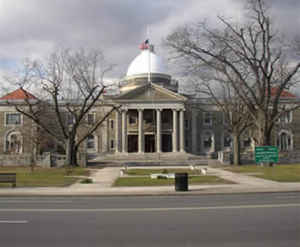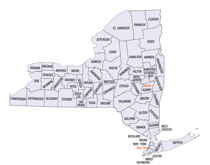New York Counties
There are sixty-two counties in the State of New York. The first twelve counties in New York were created immediately after the British annexation of the Dutch colony of New Amsterdam, although two of these counties have since been abolished. The most recent county formation in New York was in 1912, when Bronx County was created from the portions of New York City that had been annexed from Westchester County.Nassau County, New York
Nassau County Education, Geography, and History
Nassau County is a suburban county on Long Island in the state of New York. Based on the 2010 census, the county's population was 1,339,532,
estimated to have increased to 1,358,627 in 2014. The county seat is located in the Village of Garden City, within the boundaries of the
Mineola 11501 zip code. The name of the county comes from an old name for Long Island, which was at one time named Nassau, after the Dutch
Prince William of Nassau, a member of the House of Nassau, itself named for the German town Nassau. The county colors (orange and blue) are
also the colors of the House of Orange-Nassau.
Nassau County is located immediately east of New York City, within the New York-Newark-Bridgeport, NY-NJ-CT-PA Metropolitan Statistical Area.
The county is one of the four counties that occupy Long Island, together with Suffolk County to its immediate east and Queens and Kings
(Brooklyn) counties to the west, which correspond, respectively, to the New York City boroughs of Queens and Brooklyn.
Etymology - Origin of Nassau County Name
Several alternate names had been considered for the county, including "Bryant", "Matinecock" (a village within the county currently has that name), "Norfolk" (presumably because of the proximity to Suffolk County), and "Sagamore". However, "Nassau" had the historical advantage of having at one time been the name of Long Island itself, and was the name most mentioned after the new county was proposed in 1875. The name of the county comes from an old name for Long Island, which was at one time named Nassau, after the Dutch Prince William of Nassau, a member of the House of Nassau, itself named for the German town Nassau. The county colors (orange and blue) are also the colors of the House of Orange-Nassau.
Demographics:
County QuickFacts: CensusBureau Quick Facts
Nassau County History
The area now designated Nassau County was originally the eastern 70% of Queens County, one of the original 12 counties formed in 1683, and was then contained within two towns: Hempstead and Oyster Bay. In 1784, the Town of North Hempstead, was formed through secession by the northern portions of the Town of Hempstead. Nassau County was formed in 1899 by the division of Queens County, after the western portion of Queens had become a borough of New York City in 1898, as the 3 Easternmost towns seceded from the county.
Nassau, Suburbia, USA,
Edward J Smits copyright 1974
The small rural towns in Nassau County eagerly awaited New Year's Eve in 1899 and the beginning of the 1900s. Frank
Margot of Plainview witnessed the great celebration as the new year was rung in and "the large pickle and cabbage
salting factories set up a din with their whistles blowing a full blast and run by steam. There were whistles blowing at
at the brickyard and the church bells rang for hours." It was a particularly memorable time for residents of the towns
of Hempstead, North Hempstead and Oyster Bay, since the end of the old year marked Nassau County's first year of
existences as an independent county. Less than two years before, on January 22, 1898, a public meeting had been called
at Allen's Hotel in Mineola to discuss the creation of a new county. The hotel was crowded as P. Halstead Scudder called
the meeting to order and indicated the alternatives that faced the residents of the towns. The possibility of annexation
to Greater New York was dismissed, to the cheers of the audience, as entirely out of the question. Another, the idea of
creation a new county by combining Queens County's easter towns with different towns of western Suffolk, seemed unlikely
of adoption. Scudder concluded that the organization of a new county was the only solution to the problem which
confronted them.
Before the general discussion began, the meeting choose officers, headed by Benjamin D Hicks of North Hempstead as
chairman. Hicks had been a leader in previous attempts to create a new county. For his long years of work in striving
for an independent county he deserves to be called the Father of Nassau County. A popular and successful Quaker banker,
he was an intelligent and active partisipant in all types of community improvement, Archer B Wallace, son of the
assemblyman, was chosen secretary of the meetings. Discussion began after J B Coles Tappen of Oyster Bay made the
motion:
Resolved that it is the sense of this meeting that the towns of Hempstead and Oyster Bay withdraw from the county of
Queens, and that a new county to include the said towns be formed. A few dissidents took up the question of alternative
actions. North Hempstead resident W W Cock favored annexation to Suffolk County while John H Carll wanted to join New
York City, but neither proposal received support. Inclusion of Huntington and Babylon in a new county was urged by Fred
Herzog, Sr., of Oyster Bay. General James Pearsall of Glen Cove, who had been a member of the assemble in an attempt
twenty years before to create a new county, declared it would be impossible to get such a measure through the
legislature. Many of those in attendance felt, with Edward N Townsend of Hempstead, that "the county would be an
inexpensive on to govern." James H Ludlam of Oyster Bay also stressed the economy aspects, indicating people from his
area wanted lower taxes. In appropriate Long Island fashion, D N Munger closed the subject by stating that "they should
consider not what should be taken in but what barnacles should be taken off."
The chairman called for a vote and Mr. Tappen's resolution was carried with only a few dissenting votes. James Ludlam of
Oyster Bay then offered a motion which was unanimously adopted, as follows:
Whereas, It is for the best interest of the citizens of the towns of Hempstead, North Hempstead and Oyster Bay to
withdraw from the county of Queens.
Resolved that......Supervisors Underhill, Smith and Denton be requested to obtain authority....to expend a sum, not
exceeding $250. for each town in defraying any expenses.....in drafting and preparation of suck bills, as may be
necessary to corry into effect the desire of the people to have a county free from entailing alliance with the great
city of New York.
To pursue the action a committee was appointed composed of the following: P Halstead Scudder of Oyster Bay, Lott
Vanderwater and William G Miller of Hempstead, Joseph H Bogert and Wilbur Lewis of North Hempstead, James Pearsall and
James H Ludlam of Oyster Bay. The meeting closed with the proposal of several names for the count including Matinecock,
Norfolk, Nassau and Bryant. Thus began the final and successful attempt to create Nassau County.
From the Book Nassau, Suburbia, USA, Edward J Smits copyright 1974
The Dutch controlled Manhattan, then known as New Amsterdam, in 1640, when a small group of New England British arrived hoping to relocate near Oyster Bay. Dutch authorities soon forced the Englishmen eastward where they eventually established the town of Southampton.
Geography: Land and Water
As reported by the Census Bureau, the county has a total area of 453 square miles (1,173 km2), of which, 287
square miles (743 km2) of it is land and 166 square miles (431 km2) of it (36.72%) is water.
Neighboring Counties
Bordering counties are as follows:
- Queens County, New York - west
- Suffolk County, New York - east
- Bronx County, New York - west-northwest, water boundary only, across Long Island Sound
- Westchester County, New York - northwest, water boundary only, across Long Island Sound
- Fairfield County, Connecticut - north, water boundary only, across Long Island Sound
Education
Colleges and universities
Nassau County is home to numerous colleges and universities, including Adelphi University, Molloy College, Briarcliffe College, New York Institute of Technology, SUNY Old Westbury, Nassau Community College, Hofstra University, C. W. Post Campus of Long Island University, United States Merchant Marine Academy, and Webb Institute.







